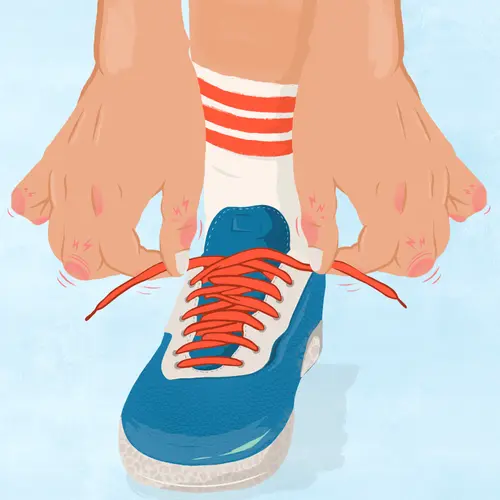The pain started in his smaller joints -- his fingers and wrists. Then it began to spread. Matt Wohlfarth, who does standup comedy part-time, first knew that something was wrong when his elbow would freeze up during shows.
“I’ve never had to use my left hand to hold a mic, and I had to start. If there were termites for people, that’s what it feels like.”
When the pain didn’t get better, his girlfriend persuaded him to go to the doctor, who diagnosed him with rheumatoid arthritis (RA).
RA is a lifelong disease in which your body attacks and damages its own tissues. It causes long-term, or chronic, inflammation of the joints. “It’s like reliving every sports injury you’ve ever had,” says Wohlfarth, 56, a former boxer. “The pain hits you in different places. Your back or knees might be sore even though you didn’t do anything to them.”
Rheumatoid arthritis is called an autoimmune disease because your immune system attacks the soft tissue that lines the surface of your joints, called synovium. The inflammation thickens the synovium and can destroy cartilage and bone near your joints. The more active your RA, the worse the inflammation.
“Left unchecked, this inflammation cascade continues to build and leads to irreversible damage to the joints,” says Robert Koval, MD, a board-certified rheumatologist with Texas Orthopedics in Austin.
Experts think your genes play a role in whether you’ll get rheumatoid arthritis. They’ve also found possible RA triggers like smoking, illnesses of the stomach and intestines (called gastrointestinal or GI), and certain infections. Any of these things may lead to the inflammation cascade that sets off RA.
There may be a connection with diabetes, too. The two conditions often happen in the same people at the same time, possibly because of inflammation throughout the body.
Research also shows that RA inflammation might raise your odds of cardiovascular diseases like strokes and blood clots, and it may lead to a higher chance of death.
Fighting Inflammation and RA Symptoms
There’s no cure for rheumatoid arthritis, but treatment that includes lifestyle changes can help you manage your symptoms, lower inflammation and pain, and prevent further joint damage.
Medication. Nonsteroidal anti-inflammatory drugs (NSAIDs), steroids, and biologic agents can ease inflammation and pain and slow joint damage. Your rheumatologist will recommend the medicines that are best for you.
Food. “Some patients feel that certain foods can trigger inflammation and will avoid these foods religiously,” Koval says. Foods that may cause inflammation include:
- Refined carbohydrates such as white bread and other baked goods
- Fried foods
- Sugar-sweetened drinks
- Red and processed meats
- Margarine, shortening, and lard
Meanwhile, some foods help fight inflammation. An anti-inflammatory diet should include:
- Tomatoes
- Olive oil
- Nuts (almonds and walnuts)
- Green leafy vegetables (spinach, kale, collards)
- Fatty fish (salmon, tuna, mackerel, sardines)
- Fruit (strawberries, blueberries, cherries, oranges)
Exercise. Research shows that when you have arthritis, exercise eases pain, improves function, and slows disability. Adults with arthritis should try to get at least 150 minutes of moderate exercise every week.
Weight loss. Keeping a healthy weight can slow RA’s progress. If you’re overweight, losing 5% of your body weight may ease stress on your joints.
Stop smoking. Smoking cigarettes can make RA worse, as well as causing other health problems. It can also make it harder for you to stay active. If you’re having trouble quitting smoking on your own, ask your doctor, or get help with a stop-smoking program.
Lower stress. Cutting out stress in your life can have a huge impact on inflammation. Try methods like deep breathing, guided imagery (focused relaxation that harmonizes the mind and body), and muscle relaxation.
Supplements. Some research shows that fish oil supplements and the oils from evening primrose, borage, and black currant plants can lower RA pain and stiffness, but more study is needed. These supplements may have side effects and interfere with medications, so check with your doctor before taking them.
“In the end, the best way to reduce inflammation is to work with your rheumatologist and get on an appropriate treatment and medication plan,” Koval says. When you partner with your doctor to find a treatment that works well, RA can go into remission.
In the 20 years since his RA diagnosis, Wohlfarth, who’s now writing a book about living with a chronic condition, has made many changes to soothe his inflamed joints. He limits stress, has a less physically demanding job, and avoids dairy because it seemed to make him feel worse. But he’s improved his RA symptoms the most by regularly taking his medication, something he admits he had trouble with at first.
“I’d get on medicine, feel better, and then stop taking it. But then I’d get five times worse,” he says. “Don’t pretend your disease has gone away. Listen to your body and take it seriously. It’s something you have to manage your whole life.”

